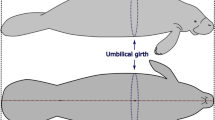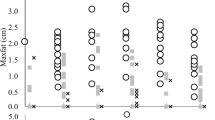Abstract
From a literature review of five wildlife ecology journals since 1937, we document how using indices to monitor ungulate body condition is common practice, with the kidney fat index (KFI = weight of fat around the kidneys/weight of kidneys without fat × 100) as the favoured tool (82% of studies). In this context, we highlight the problems of using indices when underlying statistical assumptions are not met (isometry, parallel slopes between treatments). We show, with real and simulated data for two cervids with contrasting fat storage strategies, how results from analysis of variance of KFI values differ from analysis of covariance (ANCOVA) of raw data. We conclude that the KFI is affected by the restrictions typically associated with derived index values, and as a consequence, statistical analysis of the KFI could generate spurious results leading to erroneous interpretations concerning variation in body condition of ungulate populations. Thus, we recommend analysing fat weight as an untransformed variable in ANCOVA (kidney weight as covariate) to describe body condition variation in ungulates.


Similar content being viewed by others
References
Andersen R, Gaillard J-M, Linnell JDC, Duncan P (2000) Factors affecting maternal care in an income breeder, the European roe deer. J Anim Ecol 69:672–682
Anderson AE, Medin DE, Bowden DC (1972) Indices of carcass fat in a Colorado mule deer population. J Wildl Manage 36:579–594
Batcheler C, Clarke CM (1970) Note on kidney weights and the kidney fat index. N Z J Sci 13:663–668
Dauphiné TC (1975) Kidney weight fluctuations affecting the kidney fat index in caribou. J Wildl Manage 39:379–386
Feldhamer GA, Farris-Renner KC, Barker CM (1988) Dama dama. Mamm Species 317:1–8
Finger SE, Brisbin IL, Smith MH (1981) Kidney fat as a predictor of body condition in white-tailed deer. J Wildl Manage 45:964–986
García-Berthou E (2001) On the misuse of residuals in ecology: testing regression residuals vs. the analysis of covariance. J Anim Ecol 70:708–711
Green AJ (2001) Mass/length residuals: measures of body condition or generators of spurious results? Ecology 82:1473–1483
Hewison AJM, Angibault J-M, Boutin J-M, Bideau E, Vincent JP, Semperé A (1996) Annual variation in body composition of roe deer (Capreolus capreolus) in moderate environmental conditions. Can J Zool 74:245–253
Holand Ø (1992) Fat index versus ingesta-free body fat in European roe deer. J Wildl Manage 56:241–245
Jönsson KI (1997) Capital and income breeding as alternative tactis of resource use in reproduction. Oikos 78:57–66
Kronmal RA (1993) Spurious correlation and the fallacy of the ratio standard revised. J R Stat Soc 156:379–392
Math-Soft (2000) S-Plus 2000 Professional release 3. Copyright © Math-Soft
McCoy MW, Bolker BM, Osenberg CW, Miner BG, Vonesh JR (2006) Size correction: comparing morphological traits among populations and environments. Oecologia 148:547–554
Ninov NP (2003) Somatometric characteristics of the fallow deer (Dama dama L., 1758) in Bulgaria. Acta Zool Bulg 55:43–52
Packard GC, Boardman JT (1988) The misuse of ratios, indices, and percentages in ecophysiological research. Physiol Zool 61:1–9
Packard GC, Boardman JT (1999) The use of percentages and size-specific indices to normalize physiological data for variation in body size: wasted time, wasted effort? Comp Biochem Physiol A 122:37–44
Pearson K (1897) Mathematical contributions to the theory of evolution. On a form of spurious correlation which may result when indices are used measurement of organs. Proc R Soc Lond 60:489–502
Raubenheimer D (1995) Problems with ratio analysis in nutritional studies. Funct Ecol 9:21–29
Raubenheimer D, Simpson SJ (1992) Analysis of covariance: an alternative to nutritional indices. Entomol Exp Appl 62:221–231
Riggs MR, Haroldson KJ, Hanson MA (2008) Analysis of covariance models for data from observational field studies. J Wildl Manage 72:34–43
Riney T (1955) Evaluating condition of free-ranging red deer (Cervus elaphus), with special reference to New Zealand. N Z J Sci Technol 36:430–463
Sokal RR, Rohlf FJ (1995) Biometry. Freeman, New York, USA
van Vuren D, Coblentz BE (1985) Kidney weight variation and kidney fat index an evaluation. J Wildl Manage 49:177–179
Acknowledgment
We thank Dr. Nigel Yoccoz (University of Tromsø) and two anonymous referees for constructive comments on an earlier version of this manuscript. E. Serrano was supported by a MEC postdoctoral fellowship (EX2005-1354, Spain). R. Alpizar-Jara is a member of CIMA-UE, a research centre funded by the Fundação para a Ciência e Tecnologia (Portugal) through the FEDER Plurianual Financial Program.
Author information
Authors and Affiliations
Corresponding author
Additional information
Communicated by H. Kierdorf
Electronic supplementary material
Below is the link to the electronic supplementary material.
ESM 1
(DOCX 38 kb)
Rights and permissions
About this article
Cite this article
Serrano, E., Alpizar-Jara, R., Morellet, N. et al. A half a century of measuring ungulate body condition using indices: is it time for a change?. Eur J Wildl Res 54, 675–680 (2008). https://doi.org/10.1007/s10344-008-0194-7
Received:
Revised:
Accepted:
Published:
Issue Date:
DOI: https://doi.org/10.1007/s10344-008-0194-7




